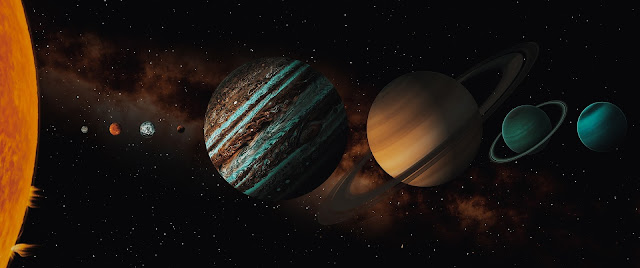6 Fun Facts About the Solar System That Will Blow Your Mind.
Ad Code Here
6 Fun Facts About the Solar System That Will Blow Your Mind.
You may think you know everything there is to know about the solar system, but we guarantee that there's at least one thing you didn’t know. From comets and asteroids to meteor showers and eclipses, the solar system is a lot more than just the sun and the moon. Find out some fascinating facts about outer space that will blow your mind in this blog post!
How big is the solar system?
The solar system is huge! In fact, there are many places we simply can’t see from earth.
We know that the sun and the planets form a disc-shaped structure called the ecliptic. If you were to look at it from earth, like in this picture, it would appear as a flat circle:
Image courtesy of NASA
For centuries, astronomers wondered if there was anything beyond this—if there was anything beyond the orbit of Neptune.(1) We now know that there is more to our solar system. We call these regions “dark matter” because we can't see them.(2) This includes Pluto and other dwarf planets like Eris and Haumea. The Kuiper Belt contains comets and asteroids.(3) Beyond this is the Oort Cloud where comets originate.(4)
Who discovered the solar system?
It may seem like common knowledge that the solar system was discovered by Copernicus and Galileo, but you never know. The truth is that the ancient Greeks were already well-acquainted with it.
The first person to suggest that the Earth and other planets orbited around a single star was Aristarchus of Samos in the third century BCE. This idea became known as the heliocentric (sun-centered) model, although it took until 1992 for this to be confirmed as factual.
Aristotle's work on natural philosophy heavily influenced scientific thought for many centuries, and he concluded that all heavenly bodies were perfect and unchanging spheres which traveled in perfect circles - an idea which would later prove to be incorrect.
How long does it take to get to Pluto?
If you were to travel at the speed of light, it would take about 5 hours to get to Pluto.
But if you're taking a more conventional route, it would still take about 4.6 years.
If you don't have that much time or money, consider booking a trip on NASA's New Horizons probe! It will make its closest approach to Pluto this July 14th, 2015.
What could happen if Earth crashes into Mars?
Ever wonder what would happen if Earth crashed into Mars? It's a terrifying thought, but scientists say it's very possible.
According to NASA's Jet Propulsion Laboratory, there is a one in 10,000 chance of an event like this happening over the next 100 years. This means that the Earth and Mars could crash into each other within the next century, and scientists say it will most likely be due to fluctuations in the orbits.
If an asteroid or comet were to crash into Mars, there is a possibility that it would change its trajectory enough for it to collide with Earth.
What about life on Earth if such an event happened? With Mars being so close to Earth—about 35 million miles away—scientists have said that we could escape some of the devastating effects of a collision with Mars because it would only take a few months for Mars' orbit to return back around us. This would cause a series of gravitational effects which could potentially alter some climates on Earth.
In fact, according to the new model from NASA's Jet Propulsion Laboratory, astronomers have found that there is about a one in 10 million chance that this collision will happen over the next 1,000 years. In other words, don't panic just yet
What happens when a comet’s orbit crosses Earth’s orbit?
Comets are chunks of ice and rock that orbit the sun and occasionally pass by Earth. When they get close to Earth, they become visible in the night sky and give off a bright light called a “tail” that looks like a long smudge.
Because comets follow what’s called an elliptical orbit around the sun, it’s possible (though rare) for them to cross Earth’s orbit. This is known as a meteor shower.
When this happens, we see meteors or shooting stars fly across the sky. These shooting stars are actually bits of dust from the comet burning up in our atmosphere!
Meteor showers
Meteor showers are one of the most impressive sights in the night sky. They happen when Earth passes through a stream of debris from a comet or asteroid.
When this happens, meteors or shooting stars can be seen falling across the sky. The common misconception is that they’re always visible on Earth during these events, but that's not true. You need to be located at an area where there are no clouds and have a clear view of the sky for you to see them at their best!
The Orionid meteor shower is an event that happens each year between October 18th and November 14th. It's one of the most popular meteor showers because it has approximately 20 meteors per hour—that is, if you're lucky enough to be able to see it!
However, if you want to watch this year's event then you'll need to find an area with low light pollution that offers a clear view of the northern sky.



0 Response to "6 Fun Facts About the Solar System That Will Blow Your Mind."
Post a Comment